|
|
|
|
|
|
|
|
7000-series Cars

The 7000-series CTA railcars have an exterior very similar to the 5000-series cars, the biggest difference being the blue front ends with a different head/tail light arrangement and black window masks. A 2-car Yellow Line train with car 7010 as the headcar speeds along the ground-level section of the line in Skokie, passing Keystone Avenue on August 5, 2021. The 7000s' presence on the Yellow Line is unusual and was only for a period during the prototypes' testing on all lines around the "L" system; once delivery of production cars began, all 7000-series cars were assigned to the Blue Line. For a larger view, click here. (Photo by Lou Gerard) |
Specifications:
Built by: CRRC Sifang America, JV
Year: 2020-?
Length: 48'-0"
Width at Floor: 8'-8"
Width at Windows: 9'-4"
Height over Roof: 12'-0"
Trucks: CRRC
Truck centers: 33' 8"
Truck wheelbase: 6' 6"
Coupler: #1 end / #2 end: Form 5 / tubular
Wheel diameter: 28"
Seats: 37
Weight (w/o passengers): 56,600 lbs
Motors per car: 4 1TB1708-0GA02 @ 120hp
Balancing speed: 70 mph
Governed speed: 55 mph +
+ The propulsion package, while capable of higher speeds, is limited by the logic of the car controls and the external signal system.
.
History:
On February 6, 2013, CTA President Forrest Claypool announced that the CTA was seeking manufacturers for a brand-new generation of railcars. The CTA issued an Invitation for Bids (IFB) for up to 846 new rail cars, which were dubbed the 7000-series in the bid documents.1
The procurement of the 7000-series railcars was intended to continue the agency's efforts to modernize the transit system to improve service and benefit customers. The cars are intended to replace rail stock that was nearing or beyond 30 years of age, with replacement of the aging cars reducing service delays from mechanical breakdowns and saving millions of dollars in operating costs.2
Design Development and Original Bid
The IFB broke the procurement into a base order and eight options, totaling 846 cars. The base order is or 100 cars, while options 1 through 8 are for 50 cars, 50 cars, 100 cars, 100 cars, 156 cars, 100 cars, 100 cars, and 90 cars, respectivelty.3
At the time the IFB was issued, CTA expected to begin taking delivery of the new cars around 2016. The 7000-series would replace the oldest rail cars in the CTA's fleet -- the remaining 400 cars of the 2600-series from the mid-1980s and the 256 1991-94-built 3200-series cars -- potentially reducing the average age of the CTA's fleet to less than 10 years by 2022. In addition, the size and number of options in the potential 7000-series car contract would allow the CTA to expand its rail fleet if ridership trends or system expansion warrants. The purchase of the 7000-series cars during the delivery of the 5000-series cars, and beginning their delivery shortly after the last 5000 is delivered, would allow for the continuous replacement of CTA's entire aging rail fleet, departing from 20 years between railcar orders that took place between the purchase of the 3200s and 5000s.4
If the options for all 846 railcars were exercised, the contract would have had an estimated value of more than $2 billion.5 The base order of 100 7000-series cars would be paid for with federal money and CTA bond proceeds already in place when the IFB was issued. The balance of orders would be funded by future federal and state funding as money is secured, as well as with future bond proceeds. However, at the time the IFB was issued, CTA officials said they could not predict when enough money would be in hand to finance rail car orders totaling $2 billion.6
The original IFB also required the 7000-series cars to be able to trainline and operate in a train mixed consist with the 5000-series cars. As such, the 7000's represent a continuation of the new family of cars that started with the 5000s. The IFB also required that the 7000's be able to couple mechanically with the 2600-, 3200- and 5000-series cars.7
The exterior and inside design of the 7000-series was not set by the IFB documents and specifications. Bidders were asked to submit exterior and interior design proposals, consisting of design options such as seating configuration and aesthetic design to ensure the new cars best meet CTA's requirements.8 The requirement that bidders submit design proposals that may differ from CTA's current railcar aesthetics and configuration comes after a mixed reaction from the public to the 5000-series cars' mostly aisle-facing seating, a seating configuration absent from Chicago rapid transit cars for several decades until the 5000s delivery. CTA said they would survey passengers about their preferences, and conduct research examining how different designs affect the time it takes passengers to board and exit trains.9
The week of April 15, 2013, CTA emailed a survey to some CTA riders, asking them to weigh in on whether they prefer the aisle-facing seats on the new 5000-series railcars, the 2-1 transverse seating of the 3200-series, or the 2-2 transverse seating of the 2600-series cars. The CTA also asked riders, if longitudinal seats are used, whether they would rather see the cloth seats on the existing "L" cars or plastic bench seats featured in New York City subway cars, as well as how they prefer to steady themselves when standing: by leaning against the train, or holding onto a pole, hanging straps or the back of a rider's seat. "The survey is one part of the research we're doing," CTA spokeswoman Tammy Chase said. "We're also studying how passengers board and alight and how they move within the cars once they're on board."10
Following the survey, and after careful study of existing design, passenger flow, capacity and comfort, the CTA announced in early August 2013 that it had developed a new, customer-friendly rail car seating configuration for the 7000-series railcars. The seating plan was a hybrid of features from previous "L" car styles, incorporating both forward- and aisle-facing seats.11 The CTA provided the seating configuration design to potential bidders, advising them to focus their proposals on a "hybrid seating design'' consisting of both transverse seating and some aisle-facing seats. It was left to the competing manufacturers to execute final designs that are functional and aesthetically pleasing, but CTA officials said the winning proposal would offer aisle-facing seats in the front of the car to maximize standing space.12
As of early August 2013, the manufacturers' bids on the 7000-series cars were due in October 2013, and CTA expected to select a manufacturer by January 2014.13
The CTA asked companies bidding on the 7000-series railcar contract to disclose how many new jobs they might create in the U.S. as part of the manufacturing project. The request for a disclosure on an American jobs plan was not a requirement by the CTA, but it is the first time the transit agency asked bidders to voluntarily submit such information. CTA said the questionnaire relating to American job creation in the bid materials was voluntarily for the manufacturers to fill out, and that the contract would still be awarded to the lowest qualified bidder. The questionnaire was added shortly before bids were due in late October 2013, but an extension until December 18 was offered for companies to fill out the optional questionnaire about their plans to hire and train American workers.14
When CTA opened the responses to the IFB on January 27, 2014, there were two bidders: Bombardier Transit Corp. and Sumitomo Corp. of America and its manufacturing partner, Nippon Sharyo U.S.A.15
Bombardier was the low bidder, bidding $1.39 billion to make the 846 7000-series cars. At the time, Bombardier was completing delivery of the 714 5000-series cars under a $1.14 billion contract. Bombardier was seen by some as having the inside track, since they were in the midst of manufacturing cars for the CTA.16
Sumitomo and Nippon Sharyo, which have not sold rail cars to the CTA before, submitted a $1.55 billion bid. Nippon Sharyo was manufacturing 160 commuter Highliner coaches for Metra's Electric District at the company's plant in Rochelle, IL. Sumitomo's bid was highly anticipated by some state and local officials because Nippon Sharyo's manufacturing plant in Rochelle could create more jobs.17
A third rail car manufacturer that expressed interest in the contract, Kawasaki Rail Car Inc., did not submit a bid.18
At the time, the CTA anticipated awarding a contract by the summer, with delivery of the first 7000-series cars occurring in late 2017 or early 2018.19
Contract Re-Bid
On May 20, 2014, CTA announced that they were rejecting the only two bids submitted to manufacture the 846 700-series railcars and instead would restart the procurement process by summer 2014 to drum up more competition and lower pricing. CTA officials said inter-connectivity between different models of railcars is desirable but not vital to operations, noting that 5000-series cars cannot be mixed in the same train with the 3200- and 2600-series cars, all of which would coexist in CTA's fleet even after delivery of the 5000's is complete.20
Another change the CTA made was the number of cars in the base order. The original IFB stipulated that the base order would start out with 100 rail cars. A larger base order is expected to spur more competition and better pricing. The new round of bidding also gives the CTA the opportunity to consider new designs and engineering changes, which could result in the 7000's looking different than the standard CTA car of the previous 40 years.21
One factor that CTA states will not change is the seating arrangement worked out for the original IFB order, which was to be a "hybrid" design consisting of a mix of longitudinal and transverse seating.22
At the monthly board meeting on June 11, 2014, CTA officials announced that the purchase of the new railcars will begin with an initial order of 200 cars, instead of 100 cars as previously planned. The CTA believed that doubling the size of the base order would result in more competition and a better price for the transit agency. The remaining options, if exercised, would still total 846 cars. CTA expected to advertise for bids by early September, with prototypes delivered for testing in Chicago in August 2018. Following successful testing of the prototypes, delivery of production cars would then follow in August 2019, at a rate of 10 to 14 cars a month.23 The later delivery of the new cars dovetails with CTA's $166 million mid-life rehab of the 1992-built 3200-series cars, which is not expected to be complete until 2019.24
CTA re-advertised for bids for the 7000-series cars on Thursday, October 16, 2014. Rather than the 200 car base discussed four months earlier, the base order was increased to 400 cars, from 100 cars in the original advertisement. The contract would still have options that allowed the purchase of as many as 846 new cars. In addition to removing the previous requirement that the 7000-series be compatible with current CTA car, other changes from the first bid solicitation includes adding two exterior cameras on each rail car and nine interior cameras, including two interior cameras in the operating cab, and consideration of alternative technologies or configurations for car systems like doors, brakes and HVAC.25
The new bid solicitation also is the first in CTA history to include a ground-breaking provision that asks bidders to provide the number and type of new jobs they will create related to the production of the new rail cars, an agreement reach by the Mayor, CTA and the Chicago Federation of Labor (CFL) in July 2014. The provision will also ask bidders to outline their job recruitment and workforce training plans.26
The CTA extended the bid-submission deadline from May 29 to July 28, 2015, at the request of some rail car manufacturers and equipment suppliers that may compete for the contract. The CTA's goal is still to award a contract in 2015, but this change also resulted in pushing the dates for delivery out farther than originally projected. The proposed 7000-series cars, originally projected to arrive around 2016, are now being pushed back to 2019 for the prototype cars that the CTA will test for up to one year. Then, after possible technical and design changes, assembly-line production of 400 rail cars would begin in 2020.27
The CTA issued two addenda to its request for bids in spring 2015. One offers manufacturers an alternative for glass insulation to provide better noise and thermal insulation. The other allows air-conditioning equipment to be split up, installed under the floor as well as in the rooftop, to provide more headroom inside the cars.28
The estimated total cost for the rail cars was $2 billion, funded through a combination of federal and local funds.29
Contract Award and Protest
On March 9, 2016, the Chicago Transit Board awarded a contract for the 7000-series to CSR Sifang America JV, which as part of its winning bid has pledged to build a brand-new rail car assembly facility in Chicago -- the first of its kind in 35 years. The facility is expected to generate 170 jobs, and represents an investment of $40 million.
CSR submitted the lowest bid of $1.309 billion for 846 railcars. CTA will purchase a base order of 400 cars first, with options to purchase the remainder in coming years.
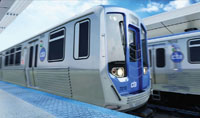
A computer-generated rendering of CSR's original proposed design for the 7000-series cars' exterior. The end cap was a new design intended to give the cars a more modern and streamlined appearance. For a larger view, click here. (Image courtesy of CTA) |
Prototype models are expected to be complete in 2019; following testing, the cars will go into service in 2020. The cars will be assembled in a new facility CSR plans to build in Chicago.
CSR is one of the world's largest rail-car manufacturers, and since 1962 has built more than 30,000 rail cars for more than 20 countries in Asia, South America and the Middle East. In the United States, CSR is building rail cars for Boston's transit system. CSR Sifang America JV is a joint venture of CRRC Qingdao Sifang Co., which is owned by the Chinese state, and CSR America, which has offices in Chicago.
On April 12, 2016, Bombardier Transit Corp. filed a formal protest of the decision to award the contract to CSR, charging that the contract was "rigged" and asserting that CSR benefited from breaches in federal law and "fraudulently" misrepresented its qualifications.30
Bombardier's protest also claimed that the Mayor Rahm Emanuel's office knew of the decision to award the contract to CSR before the CTA Board awarded the contract, even though contract evaluations are to be secret until the award is made, and that the mayor's office may have interfered in the decision-making process. The protest alleged that since 2014, the mayor had lobbied for the Chinese firm to win because of Emanuel's desire to lure Chinese investors for a variety of Chicago projects.31
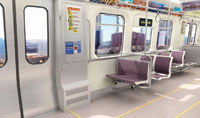
CSR prepared renderings with different interior configurations for their original bid, showing some different options for fixtures and colors. This one shows the middle section of the car with 2 x 1 seating and purple seat inserts. For a larger view, click here. (Image courtesy of CTA) |
Bombardier's bid was $226 million higher than CSR's, but the protest alleges CSR got the contract by improperly underbidding, misstating its record and through political clout. The protest alleges that CSR failed to disclose that it was disqualified from a bid to build rail cars in Boston and that the CTA "failed to determine whether CSR's price was reasonable" -- in fact, it says, the bid was "uneconomical and necessarily subsidized by the People's Republic of China," which owns the company.32
CTA spokesman Brian Steele said, "CTA has an established process in place for reviewing bid protests, which will include a thorough review of all the documents Bombardier submitted. That said, this contract was handled the same way every competitive procurement is handled. CTA is confident that all of the procurement processes and applicable laws were followed properly, ensuring a fair and equitable contract award."33
In September 2016, CTA released documents showing that the contract was awarded to CSR even though the agency's five-member internal review committee unanimously scored Bombardier's bid substantially higher -- the five-member bid evaluation panel gave Bombardier 3,667.9 of a possible 5,000 points, compared to 2,869.4 for CSR.34
However, also released was a memo by Ellen McCormick, the CTA's vice president of Purchasing who recommended the CSR offer to the CTA board, in which she confirms that "the evaluation committee gave Bombardier higher scores than it gave CSR on the evaluation criteria set forth (in the bid solicitation) before consideration of price," but states that the $226.6 million difference in the two offers outweighed the rating differences. For instance, "the most important factor to the CTA is the technical proposal submitted by the proposers," and Bombardier was rated just 2.9 percentage points higher than CSR. "If the technical proposal were the sole evaluation criterion," McCormick wrote, "I would conclude that the proposed Bombardier cars are not worth an additional price of $239.1 million." McCormick went on to dismiss other ratings differences on things such as experience, local hiring and the like as inconsequential.35
On September 28, 2016, CTA finalized its decision to award the 7000-series contract to CSR. In a decision written by Carole Morey, the CTA's Chief Planning Officer and the hearing officer in the case, Moray ruled that the $226 million difference in bids by Bombardier Transit and CSR Sifang America was sufficient to outweigh the better technical marks Bombardier got from a CTA review panel.36
The CTA "finds that the [Bombardier] protest relies on misstatements of fact, speculation, wholly unfounded accusations of misconduct and legally baseless arguments made by a proposer that simply failed to put forward the best-value proposal," Morey wrote. The differing grades the two companies received from reviewers were close enough that price became determinative, Moray also found.37
Further, according to Moray, "the record contains no evidence" that Emanuel or his office contacted anyone at CTA to influence the award. The differing grades the two companies received from reviewers were close enough that price became determinative, Moray also found.38
A spokeswoman for Bombardier said the firm is disappointed by the decision and now will review its legal options. A CTA spokesman said that Bombardier itself profited from a similar incident 10 years ago when it offered the lowest price but was out-rated by a competitor, a division of Kawasaki. Bombardier got the $1 billion deal.39
Broadly speaking, the 7000-series railcars are similar to the 5000-series cars in general aesthetics and outward appearance. Each car is 48 feet long with a curved side profile, being 8'-8" at floor height to maintain platform clearance but 9'-2" wide at seat height to allow wider seats and a wider aisle. Each car is semi-permanently coupled to another car to form a "married-pair" unit; there is a driving cab at only end end of each car, but because of the pairs there is a motorcab at both ends of each unit. The exteriors maintain the unpainted stainless steel car sides with fluting below the window line, although the front ends are different (discussed below).
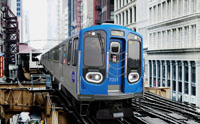
After resolution of the bid award protest and additional development time, CSR prepared revised renderings of the 7000-series cars in 2017. The final exterior car design was largely the same as the earlier renderings, but the front end was further refined including small changes to the head/tail light arrangement, extending the blue color to the bottom of the end cap, and adding the black masking around the front windows. For a larger view, click here. (Image courtesy of CTA) 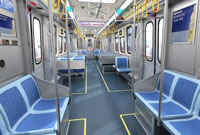
The interior arrangement in the 2017 revised rendering was largely as the cars would be built. The seating arrangement is finalized (longitudinal at the front, foreground; 2 x 1 seating in the center; and 2 x 2 seating at the rear end, background), the overhead handholds in the aisles are straps (at the side doors, the metal ring grips remained), and other details are consistent with the standards for CTA railcars. One element that still was not as it would be built were the modest panels and windscreens betweens the side doors and adjacent seats; as built, the entire assembly would be replaced with a glass panel with no solid metal lower section.. For a larger view, click here. (Image courtesy of CTA) |
Some other features of the cars carried over from the 5000s include:
The 7000-series cars also have many new features, however. These features include:40
The seating configuration of the cars was of particular interest to the public, after some criticized the largely aisle-facing seats of the 5000-series cars as uncomfortable with the seats spaced too closely and facing standing passengers being undesirable. The arrangement adopted in the 7000s was the result of extensive surveying and analysis, along with input from bidding car builders, as described above. In the seating arrangement adopted, each car is essentially divided into three zones: The front end of the car offers aisle-facing seats to maximize standing space. The middle of the car features an asymmetrical mix of forward-facing and aisle-facing single seats and seat pairs, similar to the configuration found on rail cars used on the 3200-series cars, which allows for more passengers to stand with ease. The rear of the car includes rows of forward-facing seat pairs, providing the maximum number of forward-facing seats in area that will not impede passenger flow. Additional features include two locations per car for passengers with wheelchairs. The configuration provides 37 seats, compared with 38-46 on other railcar series, but has a more even mix of forward-facing (53%) and aisle-facing (47%) seats in a design that promotes more efficiency in boarding and exiting the train while providing passengers several standing and seating choices.42
The 7000-series cars can couple mechanically to other "L" car series, but they cannot "trainline", meaning they are not electronically compatible and thus cannot run in normal service mixed with cars of other series in the same train.
CSR/CRRC Corporate Identity
In late 2014, two Chinese locomotive and rolling stock manufacturers, CNR Group and CSR Group, agreed to merge, subject to approval by the Chinese state. The combined business was renamed CRRC Corporation Limited. The merger came into effect 1 June 2015.43
After the merger process began, CRRC began efforts to expand overseas. Their first major American contract was for new subway cars for Massachusetts Bay Transportation Authority's Red and Orange lines, with a $556.6 million bid in October 2014.44
For these American contracts, CRRC created various subsidiaries through which to do business. The Boston subway car order was awarded to CRRC MA ("MA" for Massachusetts). For the CTA contract, a subsidiary CSR Sifang America, was created to bid on the job.45 Although CSR had been merged into the new CRRC a year before the 7000-series order was re-advertised in 2016, the subsidiary nonetheless used the name of one of the predecessor companies.
However, by 2017, the subsidiary had changed its name to CRRC Sifang America, matching the branding of its parent company.46 CRRC Sifang America's LinkedIn page describes themselves as "part of the family of companies of CRRC Corporation Limited".47
Factory Construction and Hiring

A rendering of the CRRC factory built on the Southeast Side of Chicago to assemble the 7000-series cars. For a larger view, click here. (Image courtesy of CTA) |
As part of CRRC Sifang America's bid to construct the 7000-series railcars, the company proposed to building a new factory in Chicago where the cars would be assembled. The plan was not only part of the company's compliance with Buy America requirements, but a commitment to provide local employment as part of the car-building project. The project was estimated to create more than 300 skilled factory and new construction jobs.48
The new CRRC facility marked the first time in more than 50 years that CTA rail cars have been produced in Chicago -- the last 'L' cars built in Chicago were the 2000-series cars in 1964,49 built at the Pullman plant at 111th Street and Cottage Grove.
CRRC Sifang America committed to hiring from communities that make up the City of Chicago and surrounding areas and is working with unions such as the Chicago Federation of Labor, IBEW and SMART, to secure a union workforce from within these communities. Working with CRRC and the Unions in this endeavor are Jobs to Move America (JMA), Calumet Area Industrial Commission (CAIC) and City Colleges of Chicago.50
The facility, paid for entirely by CRRC, will employ at least 169 factory and warehouse workers, as well as support approximately 200 construction jobs to build the facility. Approximately $7 million will be spent on training for their Chicago final assembly facility workforce.51
The new $100 million, 380,994-square-foot52 (20,000-square-meter53) facility is located at 13535 South Torrence Avenue in the Hegewisch neighborhood on the Southeast Side of Chicago.52 The facility was built by developer CenterPoint Properties.55
The factory's giant assembly hall is divided into separate functional areas. There are bogies in the manufacturing area, car-lifting machines, and two separate rooms have train tracks and maintenance ditches to conduct rain and explosion-proof tests.56
Outside the red and deep gray building are two cranes. Along the perimeter of the factory area, there are three 800-meter tracks, where all the assembled cars will be speed-tested before they are placed in service.57
On March 16, 2017, Mayor Rahm Emanuel joined Chicago Transit Authority President Dorval R. Carter, Jr., CRRC Sifang America, CenterPoint Properties, Jobs to Move America, and the Chicago Federation of Labor to break ground on the CRRC factory.58
CenterPoint started work on the roughly $40 million project in spring 201759; construction permits were issued in May 2017.
Developer CenterPoint Properties officially transferred the property to the state-owned Chinese firm in June 2018 after completing the 45-acre complex.60 Pan Ruoheng, an engineer with CRRC Sifang America Inc., said the facility is scheduled to go into production at the end of 2018 or in early 2019.61
On March 1, 2019, Mayor Rahm Emanuel joined CTA President Dorval R. Carter, Jr., CRRC Sifang America and the Chicago Federation of Labor to recognize the hiring of the initial group of employees at the factory. The hiring marks the start of employee training, with more than 70 workers hired up to that point. The first group of production workers were to travel to China in early March 2019 for highly specialized training in assembling the new railcars.62
Base Order Size and Production
The CTA's base order of 400 railcars is being manufactured for a total of $632 million or $1.58 million per car, with future options for an additional 446 railcars.63
CRRC Sifang America’s railcar manufacturing facility on Chicago’s South Side began accepting deliveries in June 2019 from U.S. manufacturers of railcar components that will be used in the production of the 7000-series railcars.64
Production of the 7000s was scheduled to begin in summer 2019. "Having recently completed the facility, we have transitioned quickly to manufacturing the 7000-series railcars for the Chicago Transit Authority," said Marina Popovic, Human Resources Director & Chief Legal Counsel for CRRC Sifang America. "The production floor and warehouse are busy receiving and sorting components from the various U.S. suppliers that will be used to build the railcars.”65
"CRRC overcame many significant pandemic-related challenges during production. In particular, CRRC battled disruptions in the supply chains of critical components and worked tirelessly to maintain a safe environment and a productive workforce in the midst of a global health crisis, to ensure delivery of the first 10 prototype passenger rail cars on schedule," said Marina Popovic, human resources director and chief legal counsel, CRRC. "While maintaining the production schedule, CRRC also continued to prioritize the highest level of workplace safety and security for its employees and never lost sight of its overall objective of delivering well-built and reliable railcars that meet the client’s unique product specifications."66
A pre-series build of 10 7000-series cars reportedly started testing at the CRRC Qingdao Sifang plant in China in mid-December 201967; it is believed these 10 cars were built for internal CRRC prototyping and testing purposes only, and will never be shipped to the US for revenue service. Testing had also begun by the second week of December 2019 on at least one 2-car unit at the Chicago CRRC plant in Hegewisch, based on video of cars operating on the test track posted in the Chicago Transit Forum online messaging site.68
The 7000s will use a majority of components sourced from U.S. suppliers. A pre-award audit found CRRC is sourcing approximately 70% of the total cost of the railcar components from U.S. manufacturers, far exceeding the contract’s Buy America requirement.69
Once delivery of the new rail cars is complete, the CTA will have its youngest rail fleet in decades, reducing the average age of CTA rail cars from 26 years in 2011 to 13 years when the 7000-series are delivered. The new rail cars are projected to save the CTA about $7 million annually in reduced maintenance costs and reduced use of power.
Prototype Units -- Cars 7001-7010 -- Testing
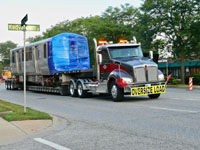
The first 7000-series car delivered to CTA, 7006, is getting close to Skokie Shop on its trip from CRRC, passing Kedvale Avenue eastbound on Dempster Street on August 13, 2020. The blue plastic over the front end of the car helps protect the front window glass as the fiberglass end cap from dings and damage while traveling by truck. For a larger view, click here. (Photo by David Harrison) |
The first 10 prototypes of the 7000-series railcars were originally anticipated to be placed into service starting in late 2019.70 71 Delivery of the first of these units were delayed by several factors, however, including global supply chain issues related to the novel coronavirus (COVID-19) pandemic of 2020.
The first 7000-series car delivered to Skokie Shops, car 7006, arrived the morning of Thursday, August 13, 2020. Its mate, 7005, arrived the next day, after which the process to pair them commenced. This was followed by the delivery of cars 7007 and 7008 on August 27 and August 28, respectively. After a month, the remaining prototype cars began ti arrive -- cars 7009 on October 1 and 7010 on October 2, respectively; and cars 7003 on October 21 and 7004 on October 22, respectively. Delivery of the ten prototype 7000-series cars was completed, ironically, with the arrival of the lowest numbered cars, 7001 and 7002, at Skokie Shops on November 18 and November 19, 2020, respectively.
Non-Revenue Service Testing
CTA began testing the first cars received, 7005-7006, before the rest of the prototype cars arrived. Following testing within Skokie Yard, CTA began testing cars 7005-7006 on main line tracks in October 2020. Cars 7005-7006 ran as a two-car train on Track 1, the southbound Purple Line Express track, between Howard and Wilson midday on October 7 and 8, when no revenue service was scheduled. The cars operated in non-revenue service, without passengers, bi-directionally on Track 1, testing the propulsion, braking, Global Positioning, leveling, public address, and other systems, as well as clearances. The cars carried CTA engineers and other personnel, to conduct tests, monitor and troubleshoot issues, and analyze the results. Additional testing with 7005-7006 was performed on the Yellow Line overnight when no service was running, from 11:30pm to 4am the next morning, on October 13-16 and October 19-21. Testing with 7005-7006 returned to Track 1 between Howard and Wilson middays on October 27 and 28.
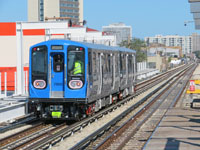
7000-series prototype cars 7005-7006 are running back and forth on North Main Track 1 during their first day of main line nonrevenue testing on October 7, 2020. The cars are moving "against traffic" (in the opposite direction trains normally go on the track) away from the camera, as evidenced by the fact that the red taillights (including the red ring around the head/taillight module) are illuminated on car 7006, indicating it is the rear of the train. For a larger view, click here. (Photo by Graham Garfield) |
On Monday, December 7 to December 10, 2020, CTA engineers conducted clearance testing on the 7000-series equipment throughout the rail system using cars 7007-7008 and 7009-7010, originating and returning to Skokie Yard daily and traversing different lines each day between 0900 and 1500 hours.
Following nearly a week of basic clearance testing across the "L" system, the prototype cars began a period of non-revenue service testing on each route. During testing, the train simulated in-service operation by making all station stops but opening the doors on whatever side of the train was opposite the platform so as not to confuse or accidentally pick up customers. Non-revenue testing continued for several months and on all the "L" lines, typically during the midday period (0900 to 1500 hours).
A 2-car train of 7000s performed non-revenue testing on the Yellow Line on December 14 and 15, 2020. A 6-car train of 7000s conduct various tests in non-revenue service on the Purple Line on December 16 and 17. The Green Line was next, where a 6-car train was used for testing December 21-23, followed by the Orange Line, where an 8-car test train was used on December 28-30, 2020. The first week of 2021 brought non-revenue 7000-series testing to the Pink and Brown lines, where a 6-car train was used on the Pink Line on January 4 and 5, and an 8-car train on the Brown Line on January 7 and 7, 2021. After a break of a few weeks, nonrevenue testing resumed on the Red Line, using 8-car trains all five days the week of January 25-29. 7000-series route-based non-revenue service testing wrapped up with five days on the Blue Line on February 1-5, 2021.
Following testing in non-revenue service on all eight "L" routes, the prototype 7000-series cars received additional evaluation and adjustments, as well as more testing. In early March 2021, coasting and braking tests were performed on the Yellow Line overnight when there was no scheduled passenger service. Over two nights, March 8 and 9, from 2330 hours to 0430 hours the next morning, emergency braking and coast contractor testing was performed on 7000-series equipment, with trains operated at 35, 45 and 55 mph to record emergency brake performance between McCormick Blvd. and East Prairie Road. On March 9, allowable speeds were turned down to 15 mph while the testing was performed.
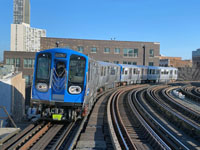
Car 7006 is at the lead end of a 4-car train of 7000-series prototype cars in nonrevenue testing, coming around Sheridan Curve and into Sheridan station on North Main Track 4, looking east on December 10, 2020. For a larger view, click here. (Photo provided to Chicago-L.org) |
A month later, various tests were conducted on 7000-series equipment, using a 4-car train of 7001-7002 and 7007-7008, systemwide on various lines on April 5-9, 2021, from 0900 to 1500 hours each day. Among the activities performed by the test train was making stops at stations, but not picking up customers. The next week, over three nights, April 12, 13 and 14, from 2000 hours to 0400 hours the next morning, additional testing was performed on the Blue and Purple lines. Again using a 4-car train of 7001-7002 and 7007-7008, the equipment's cab signal performance was tested, at times using the ATC bypass to exceed 55 mph to fully test the cab signal system. At the end of the week, during the day on Friday, April 16, cars 7001-7002, 7003-7004 and 7009-7010 were transferred from Skokie Shop to Rosemont Yard in advance of the start of revenue service testing.
Even after beginning in-service testing, a number of non-revenue tests were also run during the same period. Often these tests occurred overnight when the cars were not used in passenger service, or while the cars were assigned to lines that only ran shorter 4- or 6-car consists, leaving "extra" cars that could be used in non-revenue testing simultaneously.
Overnight on June 13-14, and again on June 14-15, from 2330 hours to 0400 hours the next morning, cars 7001-7002 and 7009-7010 were run on the Yellow Line to run tests involving power feedback when the cars were operated from live into dead third rail. Midday on Monday, July 26, two 7000-series cars were used to conduct various tests on the Yellow Line.
The week of August 9, a 4-car train of 7000-series cars was used middays to conduct truck stress-strain testing using cars equipped with special instrumentation on a different line each day -- on Monday, August 9, the train ran between Midway and Kimball; on Tuesday, August 10, the train ran on the Red, Green and Pink lines; on Wednesday, August 11, the train ran on the Blue Line; and on Thursday, August 12, the testing was conducted between Linden and 95th.
Overnight on November 7-8, from 2330 to 0400 hours, cars 7007-7008 and 7009-7010 were used to conduct additional non-revenue testing on the Yellow Line while no service was running. Midday on Tuesday, January 4, 2022, four 7000-series cars were used to conduct tests of the ATC software in non-revenue service on the Red Line between Howard and 95th.
Revenue (Passenger) Service Testing
After several months of testing in non-revenue service, CTA's new rapid transit cars entered revenue service testing in April 2021. The 7000-series prototype cars were originally planned to undergo 44 weeks of in-service testing, running on every route (and a few routes more than once), in both a summer and winter season to capture the cars' performance during Chicago's extreme seasons. In-service test trips were only run on weekdays. Interestingly, the cars entered revenue service testing almost 11 years to the day after the 5000-series prototypes began revenue service testing.
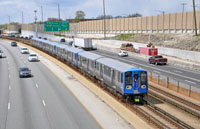
An 8-car test train of prototype 7000-series cars with car 7003 at the lead is in passenger service traveling southbound on the Blue Line approaching the Oriole Avenue bridge, having just left Cumberland, on April 21, 2021. The 7000s' first in-service testing assignment was to the Blue Line, and this was their first day in passenger service. For a larger view, click here. (Photo by Lou Gerard) |
The cars' first assignment was to the Blue Line, where they made their first in-service trip with passengers on Wednesday, April 21, 2021, on run 106. The remainder of the first week, the cars were operated by run 107 on Thursday, April 22 and run 101 on Friday, April 23. Which runs the 7000s could be used on was limited by which operators had received 7000-series training, something true on all lines the cars ran on during testing. The cars were stored at and run out of Rosemont Yard, so all trips used O'Hare Terminal-assigned operators. Each test trip used 8-car trains (with the remaining unit used for training and as a spare). The cars remained on the Blue Line through Friday, May 21.
The 7000s next moved to the Pink Line, entering service between 54th and the Loop on Monday, May 24. During the first week on the Pink Line, the train ran on run 301 Monday through Wednesday, and run 304 the rest of the week. The 7000s ran as a 4-car train, the standard length of Pink Line scheduled train consists. Testing on the Pink Line wrapped up on Friday, June 11, after which cars 7003-7004, 7005-7006, and 7007-7008 were transferred to Howard Yard overnight June 11-12 (the other two 7000 units were already at Skokie, since all 10 cars were not needed at 54th for the Pink Line's 4-car train service).
In mid-June 2021, the 7000-series prototypes began a two month stay at Howard Yard, running on the three routes operated out of that terminal. On Monday, June 14, the 7000s began a one-month stay in service on the Red Line, the "L"'s highest ridership route and the city's north-south trunk line. All 7000-series service was run as an 8-car train. During the first week of revenue testing on the Red Line, the 7000s were used on run 806 Monday and Tuesday, and run 801 the rest of the week. Red Line testing wrapped up on Friday, July 16. Still based out of Howard Yard, the 7000s began testing on the Purple Line on Monday, July 19, where it ran as a 6-car train. On Monday and Tuesday of the first week, the train was assigned to run 507, but several trips were actually operated by different runs; on Wednesday through Friday the train was on run 515. Testing on the Purple Line finished on Friday, July 30, after which it moved to revenue service testing on the Yellow Line from Monday, August 2 through Friday, August 13. Overnight August 13-14, the 7000s were transferred back to Rosemont Yard -- a crew left Skokie Yard with cars 7001-7002 and 7007-7008 to pick up cars 7003-7004, 7005-7006, and 7009-7010 in Howard Yard, and proceeded to Rosemont.
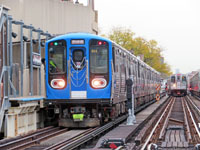
A few weeks into testing on the Brown Line, prototype 7000-series railcar 7005 leads a Kimball-bound train stopping at Wellington on November 4, 2021. For a larger view, click here. (Photo by Graham Garfield) |
The 7000-series prototype cars began a second period of in-service testing on the Blue Line on Monday, August 16, where they stayed for another month. The train ran as an 8-car consist on the Blue Line. The second testing period on the Blue Line finished up on Friday, September 17, after which all 10 cars were transferred from Rosemont to Midway Yard, overnight September 17-18.
The 7000s ran on the Orange Line for a month, from September 20 to October 15. Next, they ran on the Brown Line, from October 18 to November 12. After that, the 7000s returned to the Blue Line for a third round of in-service testing there, beginning on November 15 and finishing December 10. Next, the cars returned to the Pink Line for another round of testing there, running between 54th and the Loop from December 13 to January 7, 2022. Finally, the 7000-series prototypes were transferred to the Green Line -- the last route they had not yet been tested on in passenger service -- on January 10. They ran on the Green Line for an extended period, giving the cars experience during the winter months on some of the highest, most open stretches of elevated trackage, whose third rail sometimes ices during freezing weather (a condition the 5000-series cars had difficulty handling early on), until late March. Over the weekend of March 26-27, the 7000s were transferred back to the Blue Line. Thereafter, revenue service testing continued on the Blue Line, where they remained throughout the remainder of the prototype test period.72
Early Production Cars and More In-Service Testing
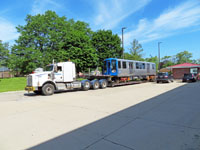
Brand-new 'early production' 7000-series car 7016 crosses onto CTA property as it is delivered by truck to Skokie Shop from the CRRC factory on the Southeast Side of Chicago on June 9, 2022. For a larger view, click here. (Photo by Graham Garfield) |
At the December 15, 2021 Chicago Transit Board meeting, the CTA Board approved a change order to CRRC's contract that, among other things, authorized the delivery of up to 16 "early production cars", in addition to the 10 prototype cars. This change allowed CRRC to continue delivering cars, but because they were not considered production cars they did not trigger the contractual step of CTA having approved completion of the testing phase, allowing testing and modifications resulting from testing to continue.73
Chinese media announced in early June 2022 that CRRC had "started delivery" of 7000-series cars "after the CTA completed operational tests on the 10 passenger rail car prototypes"74; later in June, trade media in the United Stated began to report that production cars had begun delivery,75 although these reports seemed to largely parrot the information provided by Chinese media. As of June 23, 2022, the first of this next group of cars had been delivered to the Skokie Shop, and a further seven were expected to be delivered later in June.76
However, these reports seemed to actually refer to the "early production cars" that six months earlier the CTA Board had authorized to be delivered. In fact, CTA had not concluded the contractual testing period; testing and evaluation of the 7000-series cars was completed in November 2022.77 All of the 7000-series cars during this period -- both prototypes and "pre-production" cars -- were assigned to and ran in revenue service (including in-service testing) on the Blue Line.78
Production Units -- Construction and Delivery
Once the CTA completed testing of the 10 prototype units and 16 early production units, with a satisfactory outcome of the testing regiment, the CTA authorized CRRC to proceed with final assembly and delivery of the production units.
However, production of components was already underway well before that approval was given in order for CRRC to begin production-car deliveries as soon after receiving authorization as possible. This approach is not uncommon, and had been the case when Bombardier built the 5000-series cars -- to completely pause the production line during the testing period would result in a significant lag-time to resume it once testing was completed. Any components fabricated or cars assembled before final approval for production car delivery had to be modified to meet any changes or revisions resulting from the testing period. CTA inspection personnel worked in China to conduct welded subassembly checks and production car body shell inspections for production cars.79
By June 2022, there were approximately 27 assembled car body shells and 48 cars total in various stages of completion.80 By December 2022, there were approximately 30 assembled car body shells and 60 cars total in various stages of completion; final assembly was continuing on 46 cars at the US plant.81 By June 2023, with delivery of production cars having been underway for approximately six months the number of assembled body shells and cars in various stages of completion dropped some (reflecting the reduction in the number of partial and completed cars piling up awaiting approval to resume deliveries); there were approximately 22 assembled car body shells and 58 cars total in various stages of completion at that time. Final assembly also continued on 48 cars in the US, with the Chicago facility up to car 7094.82
As of June 2023, CTA had accepted 44 7000-series cars for revenue service.83 As of October, there were 48 cars delivered and in service.84 All cars are assigned to the Blue Line.
CRRC planned to ramp-up deliveries through the end of 2023 and into 2024, with the target of delivering the contractual minimum of 10 cars a month starting mid-2024.85
|
|
1. "CTA Announces Plan for Newest Generation of Rail Cars" CTA Press Release. February 6, 2013.
2. Ibid.
3. Chicago Transit Authority. "Bid Proposal for Rapid Transit Cars." Requisition C13FI101372531, Specification CTA 7200-12. Issued February 6, 2013, page P-11.
4.
CTA Press Release (Feb 6, 2013), ibid.
5. Ibid.
6. Hilkevitch, Jon. "CTA plans to buy more rail cars," Chicago Tribune, February 7, 2013.
7.
CTA Requisition C13FI101372531, page DS 1-1.
8. CTA Press Release (Feb 6, 2013), ibid.
9. Hilkevitch (Feb 7, 2013), ibid.
10. Swartz, Tracy. "CTA seeks opinion on rail seats." Red Eye. April 16, 2013.
11.
"CTA reveals new look for next generation of rail cars." CTA Press Release. August 2, 2013.
12. Hilkevitch, Jon. "CTA trying for more 'customer-friendly' seating in future car." Chicago Tribune, August 2, 2013.
13. Hilkevitch (Aug 2, 2013), ibid.
14. Hilkevitch, Jon. "CTA will quietly nudge rail car bidders to hire Americans." Chicago Tribune, October 20, 2013.
15. Hilkevitch, Jon. "CTA rail car maker submits low bid for 846 cars." Chicago Tribune, January 28, 2014.
16. Ibid.
17. Ibid.
18. Ibid.
19. Ibid.
20. Hilkevitch, Jon. "CTA tosses out rail car bids, will start over on new fleet contract." Chicago Tribune, May 20, 2014.
21. Ibid.
22. Ibid.
23. Hilkevitch, Jon. "CTA: New rail cars expected in 2019." Chicago Tribune, June 11, 2014.
24. Roberts, Bob. "New CTA Rail Cars Not Expected Until 2019 At The Earliest." CBS Chicago, June 11, 2014.
25. "Mayor Emanuel, Chicago Transit Authority Begin Search for Manufacturer to Build New, Modern Rail Cars and Create New Jobs." CTA Press Release. October 16, 2014.
26. Ibid.
27. Hilkevitch, Jon. "CTA rounding the curve slowly on next rail car purchase." Chicago Tribune, April 26, 2015.
28.
Ibid.
29.
CTA Press Release (Oct 16, 2014), ibid.
31.0Hinz, Greg. "CTA el car deal 'rigged,' losing bidder contends". Crain's Chicago Business, April 12, 2016.
31. Ibid.
32. Ibid.
33. Ibid.
34. Hinz, Greg. "New flap arises in CTA's $1.3 billion el car deal". Crain's Chicago Business, September 26, 2016.
35. Ibid.
36. Hinz, Greg. "CTA finalizes $1.3 billion rail car deal". Crain's Chicago Business, September 28, 2016.
37. Ibid.
38. Ibid.
39. Ibid.
40. "7000-series railcars." CTA website. Accessed October 20, 2023.
41. Dongfang, Zhang. "CRRC Sifang delivered railcar to Chicago." English China News Service, June 8, 2022.
42. CTA Press Release (Aug 2, 2013), ibid.
43. CRRC." Wikipedia. Accessed January 29, 2019.
44. Ibid.
45. "China's CRRC wins $1.3 bln deal to supply Chicago rail cars." Reuters, March 10, 2016.
46. "Mayor Emanuel, CTA, CRRC Sifang America Break Ground on New CTA Railcar Manufacturing Facility in Chicago." CTA press release, March 16, 2017.
47. CRRC Sifang America LinkedIn page. Accessed January 29, 2019.
48. CTA Press Release (March 16, 2017), ibid.
49. Ibid.
50.
Ibid.
51. Ibid.
52. Ibid.
53. "Chicago, Chinese railcar maker show where there's a wheel, there's a way." Xinhua, July 19, 2018.
54. O'Brien, John. "Chinese manufacturer spends $87M on CTA rail car plant." The Real Deal. July 03, 2018.
55. Ibid.
56. Xinhua, ibid.
57. Ibid.
58. CTA Press Release (March 16, 2017), ibid.
59.
The Real Deal, ibid.
60. Ibid.
61. Xinhua, ibid.
62. "Mayor Emanuel, CTA, CRRC Sifang America Announce Hiring of Workers at New Railcar Manufacturing Facility in Chicago." CTA press release, March 1, 2019.
63. CTA Press Release (March 1, 2019), ibid.
64. "Components for CTA’s 7000 Series cars arriving in Chicago," Mass Transit, June 13, 2019.
65. Ibid.
66. CRRC Sifang America Incorporated. "CRRC Sifang America builds and delivers 10 passenger rail car prototypes on time." Mass Transit, February 2, 2021.
67.
"CRRC tests first Chicago Series 7000 metro cars," Railway Gazette, December 18, 2019.
68. "7000-series - Manufacturing" discussion thread, Chicago Transit Forum online discussion site, December 12, 2019. Accessed December 23, 2019.
69. Mass Transit, ibid.
70.
Chicago Transit Authority, Transforming Transit for the 21st Century: President's 2019 Budget Recommendations, October 2018, p.70.
71. CTA Press Release (March 1, 2019), ibid.
72. Regional Transportation Authority. "Project Management Oversight Report, December 2022", pg. 94. Accessed October 19, 2023.
73. Chicago Transit Authority. "Ordinance No. 021-127." Adopted by CTA Board December 15, 2021. Accessed online October 19, 2023.
74. Nan, Zhong and Xie Chuanjiao. "Chinese maker delivers 1st of 400 subway cars for Chicago." China Daily, June 9, 2022.
75. May, Tiana. "CRRC Delivers New Chicago Metro Trains." Railway-news.com, June 23, 2023.
76. Ibid.
77. Chicago Transit Authority, Building a Stronger Chicago Through Investments in Transit: President's 2024 Budget Recommendations, October 2023, p.53.
78. Regional Transportation Authority, "Project Management Oversight Report, December 2022", pg. 94. Accessed October 19, 2023.
79. Ibid.
80.
Regional Transportation Authority, "Project Management Oversight Report, June 2022", pg. 82. Accessed October 19, 2023.
81. RTA, PMO Report Dec 2022, ibid.
82. Regional Transportation Authority, "Project Management Oversight Report, June 2023", pg. 58. Accessed October 19, 2023.
83. Ibid.
84. CTA Proposed 2024 Budget , p. 53.
85. Ibid, p. 3.